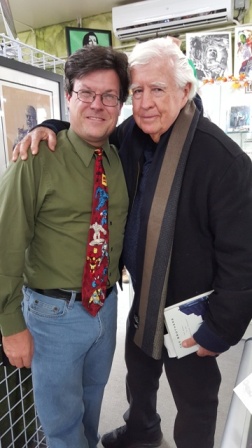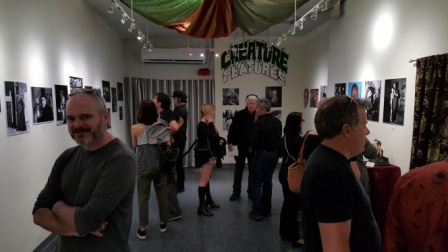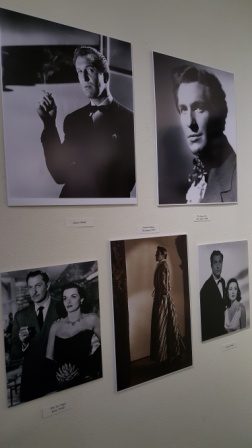(1) NATIONAL SCIENCE FICTION DAY. Today is National Science Fiction Day, the date chosen because it is Isaac Asimov’s birthday. Judging by the return on my Google search, it’s a day beloved by writers of calendar clickbait but it goes largely unnoticed by fans. Should we be doing something about it?
(2) YOU’LL GO BLIND. Self-publishing isn’t the problem – self-editing is. At least, the kind of self-editing that Diana Pharoah Francis discusses in “Writers Club: The Evils of Self Editing” at Book View Café.
I’m not saying that self-editing is bad. It’s not. It’s just we often do it while writing and that’s when it’s evil. Sometimes we do it when we aren’t aware and that’s when it’s really awful.
When I first started out writing, I wrote for me and me alone. I was trying to entertain myself and so I didn’t worry about whether this would be offensive or that would be sappy or if readers would hate my characters. None of that entered my mind because it was all about the fun of telling myself the story and getting lost in it.
Then I published. This was a dream come true. But that’s when the evil self-editor started sneaking in to my creative zone. I’d write something and then delete it because it was too something: too off-color, too disgusting, too violent, and so on. That limited me in ways that I stopped noticing. I internalized those limits and made them an unacknowledged part of my writing process. It’s like a house. You don’t pay attention to where walls are or light switches because they just exist and are necessary and you’re glad they’re there doing their job.
Only really, the self-editor at this point in the process is really a saboteur. It’s a swarm of termites eating away your writing in secret and you have no idea it’s even happening.
(3) BOUND FOR CHINA. Tomorrow Nancy Kress leaves for Beijing . “I will be teaching a week-long workshop with Sf writer Cixin Liu, SF WORLD editor Yao Haijun, and Professor Wu Yan.”
(4) CA$H CALL. Jim C. Hines is collecting data for his 2016 Writing Income Survey.
For nine years, I’ve been doing an annual blog post about my writing income. It’s not something we talk about very much, and I think the more data we put out there, the more helpful it is to other writers.
The trouble is, I’m just one data point. Better than none, of course. But this year, I decided to try something a little different, and created a 2016 Novelist Income Survey.
The process and goals are similar to the First Novel Survey I did seven years ago. (The results of that one are a little outdated at this point…) I’ll be sharing the basic data like the median, mean, and range of author incomes, as well as looking at patterns and other correlations. No personal or identifying information will be shared in any way.
(5) THEY BLINDED ME WITH (PSEUDO)SCIENCE. A site called Book Scrolling (say, are we cousins?) compiled “The Best Science Fiction & Fantasy Books of 2016 (Year-End List Aggregation)”.
“What are the best Science Fiction & Fantasy books of 2016? We aggregated 32 year-end lists and ranked the 254 unique titles by how many times they appeared in an attempt to answer that very question!”
It comes as no surprise that the results are blindingly arbitrary.
Even though it ranked first among sf books in the 2016 Goodreads Choice Awards, Pierce Brown’s Morningstar comes in #26 on this list.
And this is a list of books not just novels – the VanderMeers’ Big Book of Science Fiction is #24.
Joe Hill’s The Fireman is #4.
Charlie Jane Anders’ All the Birds in the Sky is #1.
(6) EARLY SCRIPT DOCTORING. It’s a new month – which means I can read another five LA Times articles free, so I caught up on John Scalzi’s tribute to the late Carrie Fisher from December 27 —
Out on the Internet, along with the many heart-touching tributes to Carrie Fisher, photographs of her as Leia Organa, either as princess (the original trilogy) or general (from “The Force Awakens”) and with her beloved French bulldog Gary, there’s another picture, originally placed there by cinema documentarian Will McCrabb, showing a page of the script of “The Empire Strikes Back.” On the script are several edits, in red pen, condensing and improving the script. McCrabb said the hand that put the edits there was Carrie Fisher’s, noting on Twitter that Fisher herself confirmed it to him.
Is he correct? The edits might have been made by Irwin Kershner, “Empire’s” director, instead. At the time — 1979 — Fisher would have been 22 years old. Yet here she was, looking at a script written by Lawrence Kasdan, who would go on to several screenwriting Oscar nominations, and Leigh Brackett, Howard Hawks’ secret screenwriting weapon and one of the great science fiction writers of her time, and thinking “this needs some fixing.” And then getting out her pen and doing just that.
Whoever made the edits wasn’t wrong. At least some of the edits to the scene (in which Leia, Han and Chewbacca plot a course to visit Lando Calrissian) made it to the final cut of the film. Simpler, tighter, better — and with the rhythm of speech rather than exposition (science fiction, forever the genre of people explaining things to other people). Carrie Fisher played a galactic princess, but she had a working writer’s gift for understanding how people talk, and how language works. At 22.
(7) TODAY IN HISTORY
- January 2, 1902 – Leopold Bloom takes a walk around Dublin.
- January 2, 1902 — The first dramatization of The Wizard of Oz opens, in Chicago. Book and lyrics by Baum, music by Paul Tietjens, plot reworked to provided plenty of gags and cues for irrelevant songs (and to eliminate the Wicked Witch of the West). Described in detail in Ethan Mordden’s Anything Goes: A History of American Musical Theatre, it sounds worse than the way US cinema reworked The Dark is Rising, but it was suited the audiences of the time well enough to run on various stages for seven years.
- January 2, 1905 — Elara, a Moon of Jupiter, discovered.
- January 2, 2000 — Patrick O’Brian died this date. Alan Baumler notes, “He was born on Dec 12. but I forgot to send it to you) and while his Aubrey-Maturin series of sea stories is not Fantasy/SF, given that Novik’s Temeraire series is pretty explicitly O’Brian WITH DRAGONS and Weber’s Honor Harrington series is O’Brian IN SPACE I would think it was worth mentioning.” Absolutely – and besides one of the Nielsen Haydens (I wish I could find the exact quote) said the technology in Napoleonic warships was so complex they were like the starships of their time.
(8) TODAY’S BIRTHDAY BOYS
- Born January 2, 1920 – Isaac Asimov. (Hey, wouldn’t it look bad if we forgot to list him on National Science Fiction Day?)
- Born January 2, 1929 – Charles Beaumont, known for scripting Twilight Zone episodes.
(9) WHEN IS IT TIME TO BAIL? Max Florschutz helps new writers avoid the death spiral of investing time in unproductive writing projects by a self-evaluation process, partially quoted here:
What really sets a death spiral apart, however, from a fresh project that is still in its growing stages is the amount of time that has been sunk into it. For example, when looking at your current writing project, ask yourself the following questions. If you can answer yes to even one of them, you may want to consider the possibility that you are stuck in a death spiral.
—Has forward progress stopped in lieu of going back and editing/rewriting what you’ve already written before you’ve made it very far into the story?
—Have you since spent more time editing/rewriting that first bit of the story than you did originally writing it?
—Do you get started on writing new material for said story only to realize that you need to go back and edit/add in something and gone and done that instead? Has that been your experience the last few times you sat down to work on this story? Has it kept you from adding any new material in significant amounts (say, chapters)?…
(10) OCCASIONAL ACCURACY. NASA presents “The Science of Star Trek”, but finds it difficult to marry those two concepts.
The writers of the show are not scientists, so they do sometimes get science details wrong. For instance, there was an episode of Star Trek: The Next Generation in which Dr. Crusher and Mr. LaForge were forced to let all of the air escape from the part of the ship they were in, so that a fire would be extinguished. The doctor recommended holding one’s breath to maintain consciousness as long as possible in the vacuum, until the air was restored. But as underwater scuba divers know, the lungs would rupture and very likely kill anyone who held his breath during such a large decompression. The lungs can’t take that much pressure, so people can only survive in a vacuum if they don’t try to hold their breath.
I could name other similar mistakes. I’m a physicist, and many of my colleagues watch Star Trek. A few of them imagine some hypothetical, perfectly accurate science fiction TV series, and discredit Star Trek because of some list of science errors or impossible events in particular episodes. This is unfair. They will watch Shakespeare without a complaint, and his plays wouldn’t pass the same rigorous test. Accurate science is seldom exciting and spectacular enough to base a weekly adventure TV show upon. Generally Star Trek is pretty intelligently written and more faithful to science than any other science fiction series ever shown on television. Star Trek also attracts and excites generations of viewers about advanced science and engineering, and it’s almost the only show that depicts scientists and engineers positively, as role models. So let’s forgive the show for an occasional misconception in the service of an epic adventure.
(11) SUAVE AND DEBONAIR. The Daily Beast tells everyone, “Blame Horror-Film Legend Vincent Price for the Rise of Celebrity Lifestyle Brands”.
But while Martha Stewart famously (and accurately!) said in 2013 that “I think I started this whole category of lifestyle,” the concept that Stewart began selling with her first book, 1982’s Entertaining, is a little different from what celeb lifestyle brands are peddling. Stewart—who worked as a model and in the financial industry before becoming Our Lady of the Hospital Corner—became famous due to her lifestyle of perfect taste, immaculate table settings, and painfully severe pie crust prep. In contrast, celebrity lifestyle brands—like Paltrow’s Goop, which launched in 2008 and is widely considered the OG celeb lifestyle site—hinge on the more loaded idea that celebrities have great taste because they’re rich, and if you master that taste and pick up a few celeb-approved luxury items, you might get closer to the lifestyle of an Academy Award winner (without having to do all that pesky acting training).
Despite attracting the attention of many petty haters like myself, Goop is, of course, a resounding success—according to Fast Company, in 2015 the site had one million subscribers and got more than 3.75 million page views each month. But while everyone from Real Housewives to Gossip Girls have followed in Paltrow’s (presumably Louboutin-clad) footsteps in recent years, the roots of the celebrity lifestyle brand don’t lie solely with Stewart—rather, they began in the mid-20th century, with a cookbook.
The first celebrity cookbook was penned by horror film legend and acclaimed mustache expert Vincent Price (or, at the very least, its publisher, Dover, proclaimed it as such in a 2015 press release). Called A Treasury of Great Recipes, the book—which Price wrote with his wife, Mary—drew from their world travels, collecting recipes from high-end restaurants like New York City’s Four Seasons as well as ones that the Prices whipped up while entertaining at home. And the book didn’t just feature cooking instructions; it also included shots of the Prices at play, sipping soup proffered by a waiter in black-tie dress, or simply relaxing in their gorgeously appointed, copper pot-filled kitchen.
[Thanks to John King Tarpinian, Bartimaeus, Cat Eldridge, Martin Morse Wooster, Alan Baumler, and Chip Hitchcock for some of these stories. Title credit goes to File 770 contributing editor of the day Greg Hullender.]












